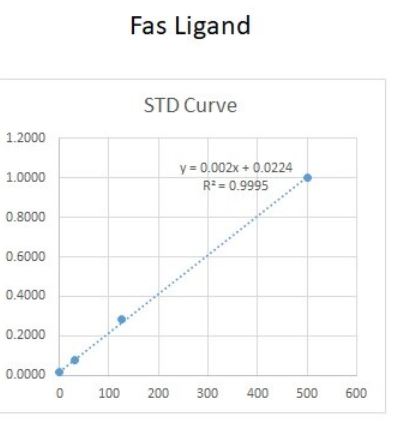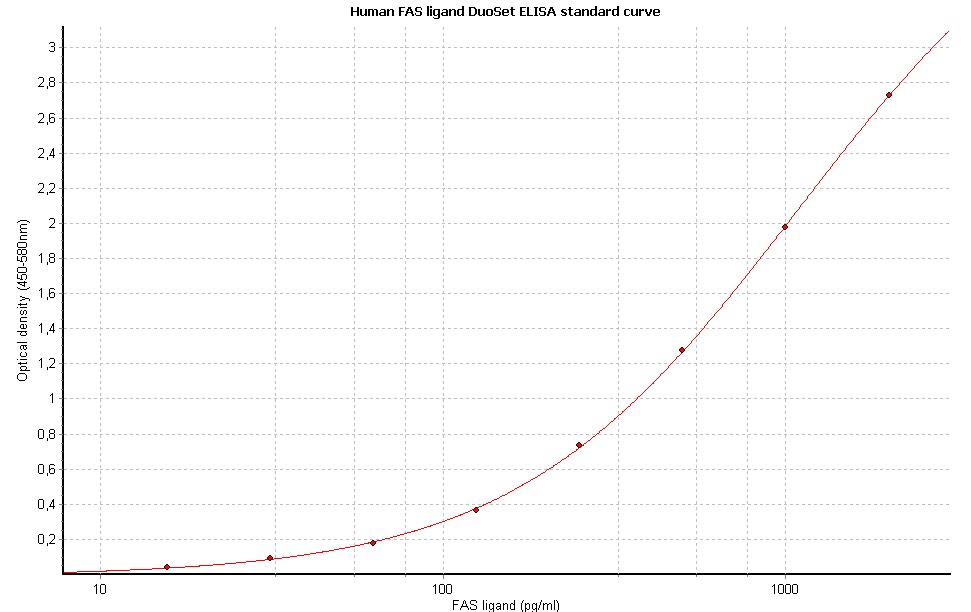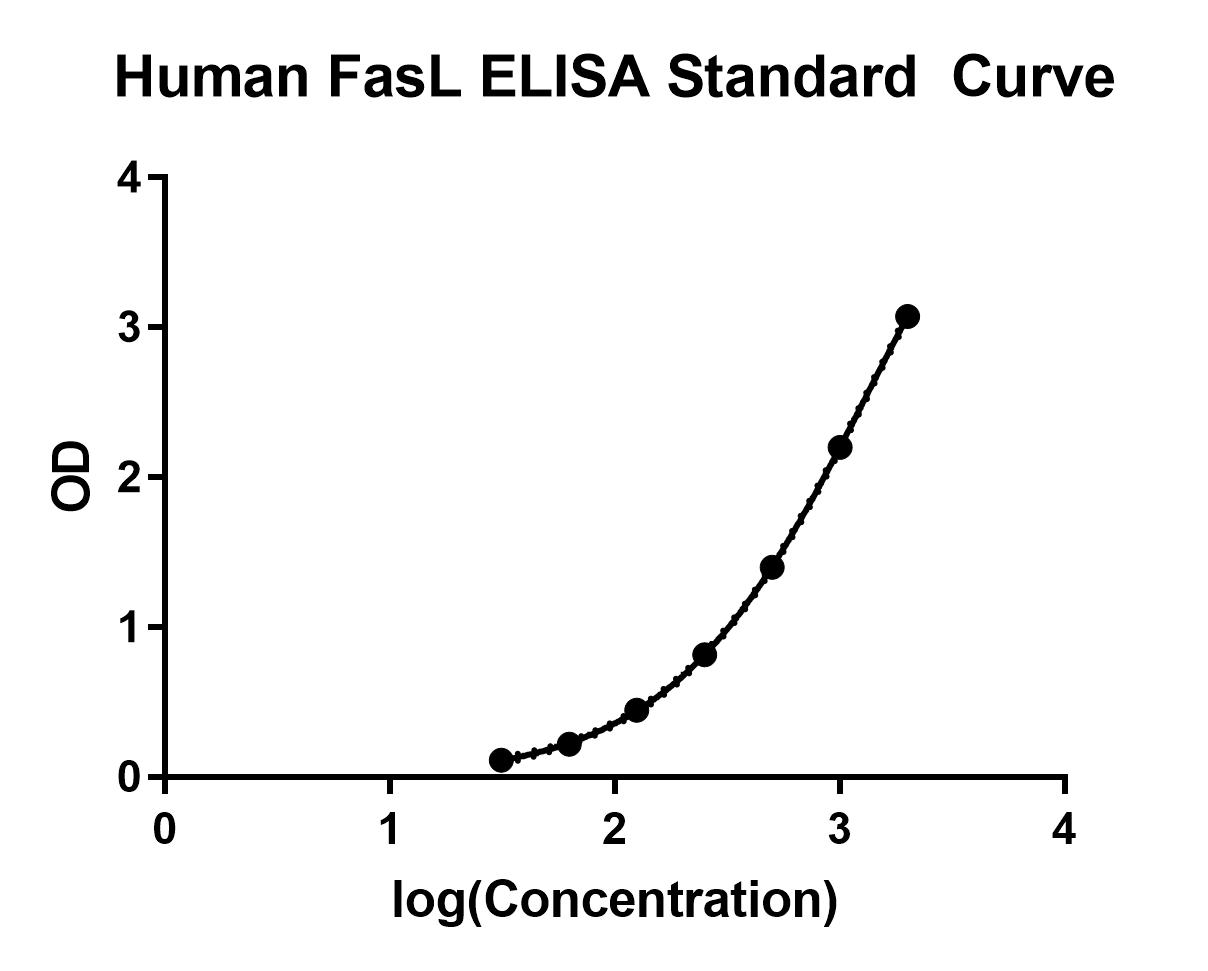Human Fas Ligand/TNFSF6 DuoSet ELISA Summary
* Provided that the recommended microplates, buffers, diluents, substrates and solutions are used, and the assay is run as summarized in the Assay Procedure provided.
This DuoSet ELISA Development kit contains the basic components required for the development of sandwich ELISAs to measure natural and recombinant human Fas Ligand/TNFSF6. The suggested diluent is suitable for the analysis of most cell culture supernate samples. Diluents for complex matrices, such as serum and plasma, should be evaluated prior to use in this DuoSet.
Product Features
- Optimized capture and detection antibody pairings with recommended concentrations save lengthy development time
- Development protocols are provided to guide further assay optimization
- Assay can be customized to your specific needs
- Economical alternative to complete kits
Kit Content
- Capture Antibody
- Detection Antibody
- Recombinant Standard
- Streptavidin conjugated to horseradish-peroxidase (Streptavidin-HRP)
Other Reagents Required
DuoSet Ancillary Reagent Kit 2 (5 plates): (Catalog # DY008) containing 96 well microplates, plate sealers, substrate solution, stop solution, plate coating buffer (PBS), wash buffer, and Reagent Diluent Concentrate 2.
The components listed above may be purchased separately:
PBS: (Catalog # DY006), or 137 mM NaCl, 2.7 mM KCl, 8.1 mM Na2HPO4, 1.5 mM KH2PO4, pH 7.2 - 7.4, 0.2 µm filtered
Wash Buffer: (Catalog # WA126), or 0.05% Tween® 20 in PBS, pH 7.2-7.4
Reagent Diluent: (Catalog # DY995), or 1% BSA in PBS, pH 7.2-7.4, 0.2 µm filtered
Substrate Solution: 1:1 mixture of Color Reagent A (H2O2) and Color Reagent B (Tetramethylbenzidine) (Catalog # DY999)
Stop Solution: 2 N H2SO4 (Catalog # DY994)
Microplates: R&D Systems (Catalog # DY990)
Plate Sealers: ELISA Plate Sealers (Catalog # DY992)
Scientific Data
Product Datasheets
Preparation and Storage
Background: Fas Ligand/TNFSF6
Fas Ligand (FasL), also known as CD178, CD95L, or TNFSF6, is a transmembrane protein homotrimer that binds to Fas/CD95 and triggers apoptosis in the Fas-expressing cell. Fas Ligand also binds the soluble decoy receptor DcR3. It is expressed on activated Th1 cells, CD8+ cytotoxic T cells, and NK cells. A soluble form can be released which remains trimeric and retains the ability to bind Fas. Fas Ligand-induced apoptosis plays a central role in the development of immune tolerance and the maintance of immune privileged sites. Tumor cells can evade immune surveillance by upregulating Fas Ligand to kill tumor infiltrating lymphocytes. In gld mice, a Fas Ligand point mutation is the cause of severe lymphoproliferation and systemic autoimmunity.
Assay Procedure
GENERAL ELISA PROTOCOL
Plate Preparation
- Dilute the Capture Antibody to the working concentration in PBS without carrier protein. Immediately coat a 96-well microplate with 100 μL per well of the diluted Capture Antibody. Seal the plate and incubate overnight at room temperature.
- Aspirate each well and wash with Wash Buffer, repeating the process two times for a total of three washes. Wash by filling each well with Wash Buffer (400 μL) using a squirt bottle, manifold dispenser, or autowasher. Complete removal of liquid at each step is essential for good performance. After the last wash, remove any remaining Wash Buffer by aspirating or by inverting the plate and blotting it against clean paper towels.
- Block plates by adding 300 μL Reagent Diluent to each well. Incubate at room temperature for a minimum of 1 hour.
- Repeat the aspiration/wash as in step 2. The plates are now ready for sample addition.
Assay Procedure
- Add 100 μL of sample or standards in Reagent Diluent, or an appropriate diluent, per well. Cover with an adhesive strip and incubate 2 hours at room temperature.
- Repeat the aspiration/wash as in step 2 of Plate Preparation.
- Add 100 μL of the Detection Antibody, diluted in Reagent Diluent, to each well. Cover with a new adhesive strip and incubate 2 hours at room temperature.
- Repeat the aspiration/wash as in step 2 of Plate Preparation.
- Add 100 μL of the working dilution of Streptavidin-HRP to each well. Cover the plate and incubate for 20 minutes at room temperature. Avoid placing the plate in direct light.
- Repeat the aspiration/wash as in step 2.
- Add 100 μL of Substrate Solution to each well. Incubate for 20 minutes at room temperature. Avoid placing the plate in direct light.
- Add 50 μL of Stop Solution to each well. Gently tap the plate to ensure thorough mixing.
- Determine the optical density of each well immediately, using a microplate reader set to 450 nm. If wavelength correction is available, set to 540 nm or 570 nm. If wavelength correction is not available, subtract readings at 540 nm or 570 nm from the readings at 450 nm. This subtraction will correct for optical imperfections in the plate. Readings made directly at 450 nm without correction may be higher and less accurate.
Citations for Human Fas Ligand/TNFSF6 DuoSet ELISA
R&D Systems personnel manually curate a database that contains references using R&D Systems products. The data collected includes not only links to publications in PubMed, but also provides information about sample types, species, and experimental conditions.
6
Citations: Showing 1 - 6
Filter your results:
Filter by:
-
Secreted Fas decoys enhance the antitumor activity of engineered and bystander T cells in Fas ligand-expressing solid tumors
Authors: P Bajgain, AG Torres Cha, K Balasubram, L Fleckenste, P Lulla, HE Heslop, J Vera, AM Leen
Oncogene, 2022-11-02;0(0):.
Species: Human
Sample Types: Cell Culture Supernates
-
Complement Factor C5a Inhibits Apoptosis of Neutrophils-A Mechanism in Polytrauma?
Authors: C Ehrnthalle, S Braumüller, S Kellermann, F Gebhard, M Perl, M Huber-Lang
Journal of Clinical Medicine, 2021-07-17;10(14):.
Species: Human
Sample Types: Serum
-
Circulating Ligands of the Receptor for Advanced Glycation End Products and the Soluble Form of the Receptor Modulate Cardiovascular Cell Apoptosis in Diabetes
Authors: JN Tsoporis, E Hatziagela, S Gupta, S Izhar, V Salpeas, A Tsiavou, AG Rigopoulos, AS Triantafyl, JC Marshall, TG Parker, IK Rizos
Molecules, 2020-11-10;25(22):.
Species: Human
Sample Types: Plasma
-
CXCL9, CXCL10, and CXCL11; biomarkers of pulmonary inflammation associated with autoimmunity in patients with collagen vascular diseases-associated interstitial lung disease and interstitial pneumonia with autoimmune features
Authors: M Kameda, M Otsuka, H Chiba, K Kuronuma, T Hasegawa, H Takahashi, H Takahashi
PLoS ONE, 2020-11-02;15(11):e0241719.
Species: Human
Sample Types: Serum
-
Suspension microarrays for the identification of the response patterns in hyperinflammatory diseases.
Authors: Hsu HY, Wittemann S, Schneider EM, Weiss M, Joos TO
Med Eng Phys, 2008-03-03;30(8):976-83.
Species: Human
Sample Types: Plasma
-
Human CD4+CD25+ regulatory T lymphocytes inhibit lipopolysaccharide-induced monocyte survival through a Fas/Fas ligand-dependent mechanism.
Authors: Venet F, Pachot A, Debard AL, Bohe J, Bienvenu J, Lepape A, Powell WS, Monneret G
J. Immunol., 2006-11-01;177(9):6540-7.
Species: Human
Sample Types: Cell Culture Supernates
FAQs
No product specific FAQs exist for this product, however you may
View all ELISA FAQsReviews for Human Fas Ligand/TNFSF6 DuoSet ELISA
Average Rating: 4 (Based on 3 Reviews)
Have you used Human Fas Ligand/TNFSF6 DuoSet ELISA?
Submit a review and receive an Amazon gift card.
$25/€18/£15/$25CAN/¥75 Yuan/¥1250 Yen for a review with an image
$10/€7/£6/$10 CAD/¥70 Yuan/¥1110 Yen for a review without an image
Filter by:
We used this kit for the quantification of Fas Ligand in human serum and plasma. Works ok and well-described protocol.
We ran human EDTA plasma samples at a 1:5 dilution for this assay. Due to high variation between samples an 8th standard was added








